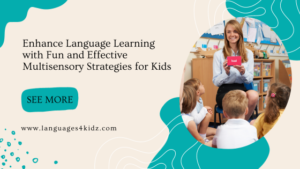12 Ways to foster community engagement and cultural events
Teaching young language learners a foreign language can be a rewarding experience, not only for educators but also for the students themselves. Beyond the language skills, it offers a unique opportunity to promote cultural awareness and foster a sense of community. In this blog post, we will explore strategies to enhance community engagement and incorporate cultural events into foreign language teaching for young learners.

- Create a Multicultural Classroom Environment: Start by establishing a classroom environment that celebrates diversity. Decorate your classroom with flags, posters, and cultural artifacts from the target language-speaking countries. This visual exposure helps immerse students in the language and culture.
- Cultural Show and Tell: Encourage students to bring in items from their own cultural backgrounds to share with the class. This promotes an exchange of ideas and can spark curiosity about different cultures.
- Cultural Competence Through Music and Dance: Incorporate music and dance from the target culture into your lessons. Teach traditional songs or dances and organize class performances. It’s a fun way for students to connect with the culture while practicing language skills.
- Cultural Projects: Work with children on arts and crafts projects of various aspects of the target culture. This encourages independent learning and deeper cultural exploration.
- Cultural Cuisine Days: Organize occasional cultural cuisine days where students can bring in or prepare dishes from the target culture. This sensory experience can be a gateway to understanding cultural nuances related to food.
- Field Trips and Virtual Tours: If possible, plan field trips to cultural centers, museums, or restaurants that showcase the target culture. Alternatively, take advantage of virtual tours and online resources to explore cultural landmarks and historical sites.
- Guest Speakers and Cultural Ambassadors: Invite native speakers or cultural ambassadors from the target country to speak to your class. They can share insights about their culture, customs, and experiences, making the language more relatable for students.
- Storytelling and Folktales: Share traditional stories and folktales from the target culture. This not only exposes students to the language but also imparts valuable cultural lessons and moral values.
- Language Exchange Partners: Connect with schools or organizations in the target country to set up language exchange partnerships. This allows students to interact with native speakers, improving their language skills and cultural understanding.
- Festivals and Holidays: Celebrate festivals and holidays from the target culture. Explain their significance, customs, and traditions to your students. Create decorations and engage in activities related to these events.
- Language Clubs and Cultural Extracurriculars: Establish language clubs or extracurricular activities where students can delve deeper into the language and culture. These clubs can organize cultural events and language-related contests.
- Community Involvement: Encourage students to participate in local cultural events or volunteer activities related to the target culture. This real-world engagement reinforces classroom learning.
Teaching young language learners a foreign language goes beyond grammar and vocabulary. It’s an opportunity to open doors to new cultures and build a sense of community. By incorporating these strategies into your teaching approach, you can create an enriching and immersive language-learning experience that will benefit your students for years to come. Embrace diversity, celebrate culture, and watch your students flourish in their language journey.
Languages4kidz Curriculum Resources

Our Spanish and English curricula are packed with relevant thematic lessons, resources and tools to nurture a love and respect for other languages and cultures in children from all over the world.







